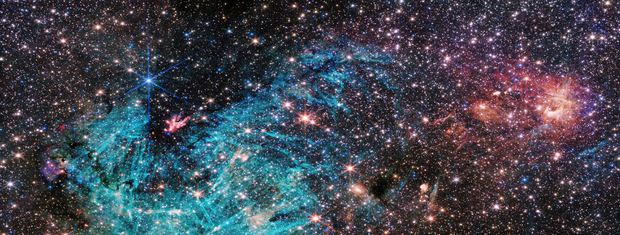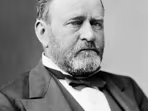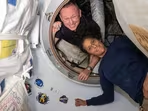Webb telescope captures cluster of baby stars in the center of the Milky Way
The James Webb Space Telescope captured an image of the dense center of the Milky Way, a chaotic region of space, NASA said on Monday.
The image features Sagittarius C, a star-forming region about 300 light years from the Milky Way's central supermassive black hole, Sagittarius A. Some 500,000 stars are visible in the image, including a cluster of still forming baby stars, known as protostars. The protostars, which are still gaining mass, "glow like a bonfire in the midst of an infrared-dark cloud," according to NASA.
"There's never been any infrared data on this region with the level of resolution and sensitivity we get with Webb, so we are seeing lots of features here for the first time," Samuel Crowe, the observation team's principal investigator, said. "Webb reveals an incredible amount of detail, allowing us to study star formation in this sort of environment in a way that wasn't possible previously."
What's in the new James Webb image?
One of the baby stars captured by the Webb telescope is a protostar that's more than 30 times the mass of the sun.
A dense cloud blocks light from reaching Webb, making the region of space shown in the image appear less crowded than it actually is.

"There are turbulent, magnetized gas clouds that are forming stars, which then impact the surrounding gas with their outflowing winds, jets, and radiation," Rubén Fedriani, a co-investigator of the project at the Instituto Astrofísica de Andalucía in Spain, said.
A previously unseen region of ionized hydrogen gas wraps around the dense cloud of dust in the image, according to NASA. The space agency described "needle-like structures" in the ionized hydrogen. They appear to be chaotically oriented in many directions. Crowe plans to examine them further in future studies.
"Massive stars are factories that produce heavy elements in their nuclear cores, so understanding them better is like learning the origin story of much of the universe," Crowe said.
What are scientists hoping to learn from the region of space?
The area, which is around 25,000 light years from earth, has a galactic center that's close enough for astronomers to study individual stars with the help of the Webb telescope. NASA said it will give scientists access to unprecedented information about how stars form.
"The galactic center is the most extreme environment in our Milky Way galaxy, where current theories of star formation can be put to their most rigorous test," Jonathan Tan, a professor at the University of Virginia's astronomy department and one of Crowe's advisers, said.
- In:
- James Webb Space Telescope
Aliza Chasan is a digital producer at 60 Minutes and CBSNews.com. She has previously written for outlets including PIX11 News, The New York Daily News, Inside Edition and DNAinfo. Aliza covers trending news, often focusing on crime and politics.
TwitterDisclaimer: The copyright of this article belongs to the original author. Reposting this article is solely for the purpose of information dissemination and does not constitute any investment advice. If there is any infringement, please contact us immediately. We will make corrections or deletions as necessary. Thank you.
Title:Webb telescope captures cluster of baby stars in the center of the Milky Way
Url:https://www.investsfocus.com








